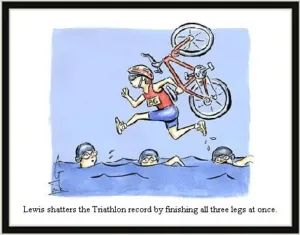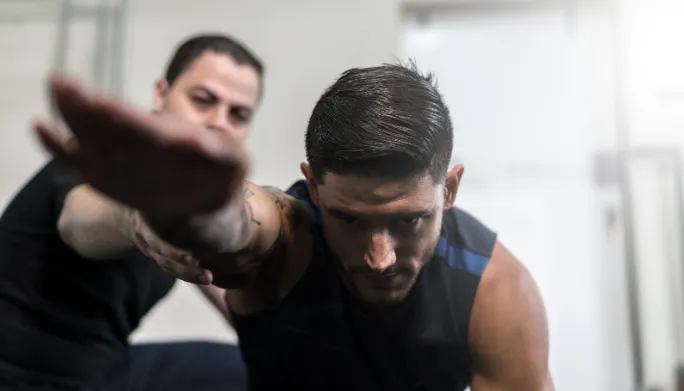If you’re registered for or just thinking about attempting a triathlon, you’re already familiar with the swim, bike, run format. But for most new triathletes, the question becomes, “How do I train for this?” followed quickly by, “What takes precedent in training?” In this three part series blog we will provide you with some basics of where to start your training plan for each of the 4 elements of tri training….including strength training. For each of these segments we will focus on training with INTENT. In our first post we started with the Bike. This time we’ll talk you through Transition 2 and the Run.
DISMOUNT!
You see it in bright spray paint on the road or a huge sign with flags and people are yelling at you to, “GET OFF YOUR BIKE!” Transition 2 can be a hectic place in which many accidents happen for new triathletes. There are those who get run over by other cyclists coming in, those who can’t get out of their pedals and just fall over while locked in to avoid crossing the no ride zone line, and those who get penalized or disqualified for failure to execute in time. It’s also the point in your race in which you’ve gone from sitting down back to standing up and expecting your legs to know how to stop making circles and now support you as you walk and eventually run. T2 also comes with more gear changes including shoes (maybe new socks), fuel (depending upon the length of your run portion) and remembering to take OFF the helmet.
The good news in all of this is that transitions are an easy skill of triathlon training to practice. Many do this in the form of a BRICK workout. Brick workouts are simply stacking any two components of the triathlon into the same practice; a more traditional brick workout may include a short run at the end of your regular ride. Why a “brick”? Well, some people think the name comes from the idea of stacking workouts like building blocks, others describe the way your body feels heavy like a brick at the end of a long ride when transitioning to run (all the more reason to practice and teach the body that it’s okay to keep moving and differently), and there’s even a fun acronym associated with the name: Bike Run It Can Kill. No matter what you call it, this workout type can also be a great place to practice improving your transition time by setting up a similar transition station and practicing getting in and out of the transition zone quickly. It’s also important to practice that dismount and figure out what movements you can do during transition to help the body recalibrate to run mode.
Training Peaks Coach Carrie McCusker suggests the following:
- Mentally shift at the end of your bike to the run
- If it’s safe to do so, stand up while you ride a few times to change the body position and blood flow
- Try some high cadence spins
- Stretch your running muscles a bit with a focus on the hamstrings and and loosening the back
- Consider your fuel and hydration and if you’re prepared to tackle a run
Because transition is about being quick and efficient, it’s a great idea to follow some of the simple tips found in this video:
The End is Near
So, you’ve made it to the run and do you know what the #1 mistake made by triathletes is on the run?
Starting off TOO FAST!
Here are some tips to remember when training for or headed into the run on competition day:
- Train in a variety of ways! We’ve already touched on BRICKs, but runners also need to incorporate hill runs and trail runs, speed days and distance runs to be successful on competition day. See below some suggested runs for varying your workout.
- Have the right shoes and take care of your feet. We have an upcoming blog about how to transition to a zero-drop shoe, but you should also consider the resistance training that goes into making a healthy foot.
- Learn better form and technique. CTG offers Clinical Run Analysis to improve your gait mechanics, increase speed, improve running economy, and run pain free.
- Get in the gym. Why is running so difficult for triathletes? This article from Scientific Triathlon defines running as, “a series of one-legged jumps”. How is anyone supposed to keep jumping on one leg effectively for miles and miles without strength training, core training, and plyometric training?

Mix It Up
As we stated a moment ago, runs should be varied in your training. Consider trying one of the workouts below programmed by Dr. Brandon. The first is a Threshold workout meant to help build your aerobic capacity while training through some anaerobic intervals. This workout uses Zone Training. Not sure what your zones are? Check out this graphic to get an idea:

Next, we have a VO2 Max run which is about hitting Zone 5 and testing the limits. Finally, we finish off with an endurance run. Some coaches will tell you that the majority of your runs (especially when training for longer distances) should be endurance runs. It may be hard for some athletes to stay in that Zone 1-2 space, but as noted below, it’s VERY important to learn how to do that!
Threshold Run
Warm up:
10 minutes zone 1/2 + (5) 10-second pick ups
Main set:
8 x 1-minute zone 4 + 3 minutes zone ½
Warm down:
5 minutes zone 2 steady
VO2 Max
Warm-up:
10 minutes zone 2
Main set:
4 x (90 seconds zone 5 + 2 minutes zone 1/2)
2 x (3 minutes zone 5 + 2 minutes zone 1/2)
6 minutes zone 4 + 2 minutes zone 1/2
Warm down:
5 minutes steady zone 2
Base Endurance Run:
60 minutes at zone 1/2
*It is very important to progress and improve your running capacity to stay within the lower zones for this run. Too much time spent running in zone 3-5+ will lead to diminished adaptation from previous training sessions.
From the Ground Up
At CTG our foundation of injury free athletes is built on a foundation of strength to improve all areas of training.
For the run that means:
Dynamic stability
Single leg patterns
Hip flexor strength
Hip extension strength
Hip & core control
Mid back mobility & strength
Calf strength
Try incorporating some of the exercises below from Dr. Brandon, or sign-up for our Run Strong Group to help improve your endurance training performance!
Exercises to Improve Running
Rotational & anti-rotational core strength: Split stance paloff press + rotation
Single leg marching & rotational single leg patterns: Single leg rotational lunge + march
Sub max plyometrics for tendon health: Stagger stance pogos
Hip & core control in sport specific positions: Rear foot elevated hip abduction
Calf raise variations: Weighted front foot elevated + rear foot calf raise
Ankle & foot control: Forefoot isometric taps


